History of Łódź
Łódź is located in central Poland and is the third-largest city in the country. For hundreds of years it was a non-important village. The big change arrived at the first quarter of the 19th century when it was decided on a massive industrialization program and transformation of the town to a large industrial center.

15th to 19th century

Łódź itself, called Łódka, existed already in the 12th century, but the first records of this agricultural settlement date back to 1332. It was first a prince's village, but then it came under the control of the Włocławek bishops. It happened in 1332 based on the decision of Władysław Garbaty, the Duke of Łęczyca.
On July 1423 King Władysław II Jagiełło awarded Lodz status of city. Up to that point it was a village under the ownership of Kujawy Bishop. The term 'city' applies to the legal/administrative status of the local authority and not to the number of residents. For hundreds of years later Lodz was still a village consisting of no more than 1,000 people.[1]
The market square was probably marked out in 1414 during the founding of the city on the initiative of the Włocławek bishops. In 1423, when granting municipal rights, King Władysław Jagiełło authorized the "weekly market every Wednesday and yearly twice a year". A wooden town hall was built on the market square, later destroyed in unknown circumstances. Another one, created in 1585, survived until the 18th century. The market was re-regulated in 1821 and gradually built up with tenements.[2]
At the beginning of the 15th century there were fifteen villages in today's boundaries of Łódź. There were forests around. As majority of the then small commercial and agricultural towns, it was a market and an inn for a dozen or so neighboring villages. Also, like most cities in Central Poland, it never had walls or and was an open city.
In 1561, the residents of Łódź obtained a construction permit for the town hall, but it was not until 1585 that a contract was concluded with the townsman Michał Doczkałowicz for its construction. He fulfilled his promise and erected a wooden building, for which he obtained the right to use one of the rooms as an inn.
The settlement of Łódź was at the Piotrków route towards Piotrków Trybunalski and served the customs chamber on the Ostroga River. This chamber belonged to the king, but it was rented by the archbishop of Gniezno. However, he allowed all customs duties to be collected by the bishop of Włocławek and he was supposed to pay the lease to the king.[3]
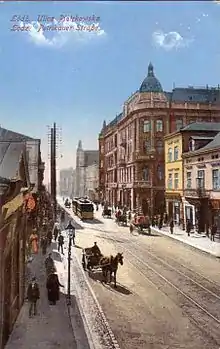
It is near this settlement that the oldest parish of the Assumption of the Blessed Virgin Mary was created in Łódź. Its origins date back to the fourteenth century. It is believed that it was erected between 1364 and 1371 by the Archbishop of Gniezno Jarosław Bogoria Skotnicki and until 1885 it was the only parish in Łódź. Such villages, which later became districts incorporated to the city, such as Bałuty, Doły or Radogoszcz belonged to it. The first priest of this parish was Father Piotr Śliwka.
The brick church standing on Church Square is the third temple in this place. The first of the wooden churches was built in the fourteenth century, when the parish was established. The second, three times the size of the old one was built between 1765 and 1768. This was done at the behest of Włocławek's bishop Antoni Ostrowski.
Almost opposite the settlement of Lodz, around 1410 the village of Ostroga was established. It was on the right side of the Ostroga River, which was later called the Łódka and was opposite to the settlement of Lodz.
During the 16th century, around 700 people lived in Łódź. New houses were built around the Old Market Square. A street called Nad Rzeką was coming out of it. Then they began to be called Nadrzeczna, later Podrzeczna, and finally Drewnowska, apparently, the latter name was given to the influential Drewnowicz family from Łódź.
The 17th and 18th centuries were a turbulent period in the history of Poland, and also the time of the fall of Łódź. Wars, and especially the Swedish Deluge of 1655 destroyed the city very seriously. The Swedes burned 25 houses and murdered some of the townspeople. In 1661, a fire and plague passed through the city. At the end of the 17th century, the city rebuilt slightly and had 64 houses.
During the reign of King Stanisław Poniatowski, the bishop of Włocławek gave the inhabitants of Łódź the last privilege, i.e. he abolished his eternal duties and established rent in money as the only form of benefits for the owner. However, this reform did not manage to enter into force. The second partition of Poland came. In 1793 Łódź was in the Prussian partition. The Prussians took the goods from the bishops. end of the 18th century the town had only 190 inhabitants and only 44 houses, all buildings were wooden, no road was paved.
Modern period
In the second decade of the 19th century, the area of its urban development, later the Old Town, was small and amounted to 20 ha. The urban layout has retained the typical features of the medieval layout until then. It was characterized by a network of narrow streets, leaving slightly obliquely from the Market Square and enclosing buildings in small, irregular blocks. The central part of the layout was marked by a market square, separated by an inter-market block from the square where the church stood. The whole town development was limited to housing these squares and the initial sections of eight streets, some of which crossed the road to nearby cities and took their names from them. Dense building development occurred only at the Market Square and along the market streets: Drewnowska, Podrzeczna, Nadstawna and Kościelna (known until the end of the first half of the 19th century as Piotrkowska).
Becoming industrial city
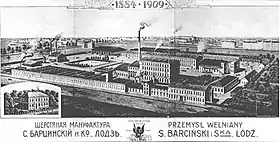
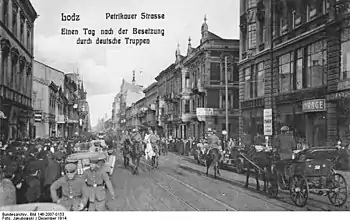
In the 1815 treaty, it was planned to renew the dilapidated town and with the 1816 decree by the Czar a number of German immigrants received territory deeds for them to clear the land and to build factories and housing. Their incentives for settlement included "exemption from tax obligations for a period of six years, free materials to build houses, perpetual lease of land for construction, exemption from military service or duty-free transport of the immigrants’ livestock."[4] In 1820 Stanisław Staszic aided in changing the small town into a modern industrial centre.
In the vicinity of Łódź there was no possibility of developing mining and metallurgy, for that favorable geographical and political conditions of development were mentioned above industry, which is why the authorities decided to create a textile industry. At that time, abolition of customs border between Congress Poland and the Russian Empire had a very important economic and political stimulus for the development of the textile industry in the Poland and the huge opportunities associated with it.[5]
It was decided that the "New Town", to be located south of the existing "Old Town", at the opposite side of the Łódka river. The main reason was the land extending there belonging to the government. The new industrial Łódź created at that time was not simple continuation of the feudal town. It was not created through its evolution functional or by gradual reconstruction of the medieval layout design for new industrial needs. On the contrary, it is fully deliberate it was created outside, in the so-called "Raw root". Rajmund Rembieliński in 1820 personally designated a place on the market for the new settlement and defined the direction of future streets. He chose the culmination of the local hill through which he went along the Piotrków route ran along which several local roads converged. The new settlement had assumed to be separate, though officially still a part of an existing city, therefore it was necessary to keep as far as possible integration, which was best provided by the new one Piotrków route, connecting the areas on both sides of the river in the shortest line.[6]
Second World War
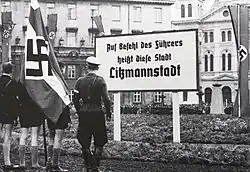
At the very beginning of the war, Łódź became a victim of German aggression. The earliest enemy bombs fell in the area of Kaliska Railway Station and at Lublinek Airport outside the city. During the first week, economic life in Łódź came to a halt. The raids of German Air Force completely disorganized the work of offices and institutions. They caused difficulties and interruptions in traffic. The population was constantly forced to seek shelter in the basements, shelters and anti-aircraft ditches. Polish Air Force and anti-aircraft artillery, which were insufficient in quantity and strength, were not able to effectively counteract the brutal attacks of the enemy. Traffic restrictions on Piotrkowska, Nowomiejska, Zgierska and Pabianicka streets were introduced on September 1. They were intended to facilitate the passage of military units through the city. [7] On September 5, German troops smashed both wings of the Łódź Army during the Battle of Łódź and opened their way to the city. Even the previous day, wealthier residents began to leave the city. Military and state authorities - headed by voivode Henryk Józefski and the town staroste Henryk Mostowski, self-government with president Jan Kwapiński and the police left the city as well, and on the night of 4–5 September the evacuation of offices and institutions began a process which lasted until noon on September 6. The city was deprived of all means of transport. Ambulances and Fire Brigade equipment were also taken away. At the same time, the inhabitants fled from Łódź en masse, following the Brzeziń road to Warsaw. German aircraft fired on evacuating civilians, causing casualties among defenseless refugees.[8]
On September 6, an organizational meeting of the Citizens' Committee of the City of Łódź took place in the City Hall at Wolności Square 14. It was established to take over the management of the city abandoned by the authorities and partially depopulated. The meeting was attended by representatives of social, political and economic organizations, and was headed by suffragan bishop Kazimierz Tomczak. Six departments were established: Legal, Financial, Provisional, Educational, Social Welfare and Health. They were to direct the work of existing individual departments of the City administration. Matters of security and public order passed into the hands of the Citizens' Militia, which had been operating as an organization to fight usury and sabotage since 27 August and was now subordinated to the committee. On September 11, the occupiers issued the first ordinances. They ordered residents to, among others surrender of possessed weapons and introduced a curfew.
On September 14, the Committee moved its headquarters from the City Hall building to the premises of the Chamber of Commerce and Industry at 3 Kościuszki Avenue. This was dictated by the desire to separate from the Germans, who located the Commandant's Office and the police in the building of the City Hall.
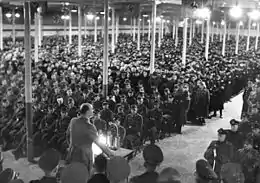
On 16 September, the German City Commissioner took power over the local government in Łódź. It was Mayor Dr. D. Leister from the Rhineland. State offices were subordinated to the head of the Civil Administration at the command of the 8th Army, Dr. Harry von Craushaar. This board was the highest authority of the civil administration in Łódź. It operated as part of the German military administration. As the occupation regime progressed, the situation in the city systematically deteriorated. The assaults of German soldiers on the flats of the Polish and Jewish population intensified. They were accompanied by plunder of property. There were frequent arrests and beatings of Polish policemen. In early October, the Germans liquidated the Civic Militia. Police terror increased. The position of the Citizens' Committee prof. Zygmunt Lorentz, a member of the Presidium and first secretary of the Committee, and has been acting as the temporary government that was set up to handle city affairs following the collapse of the government was getting more and more difficult. The Committee's powers have been systematically narrowed and it mainly focused on charity. It provided aid to pensioners, reservists and others in need of help. It organized this action with great dedication until the very end, until the funds were exhausted.
Due to its industrial character, the city was an important economic center for the Nazi administration. The German authorities intended to become the main city of the district. It was planned to resettle Germans from Wołyń and Bukowina to it. Poles were to be a workforce in factories managed by the Germans.[9]
The Nazi authorities, which gave Łódź the status of a separate city, divided the city into four administrative districts, and seven more were created in suburban areas. Streets in the city were given new, German names: One of the main streets in the city, Piotrkowska Street was renamed Adolf-Hitler-Straße.[10] The previous coat of arms of Łódź - the golden boat in the red background, has been changed to a golden swastika on a navy blue background, and the city colors from gold-red to navy blue, the colors of the Litzmann family.[11] From April 8, 1941 to 1 of June 1943, Werner Ventzki was the mayor of occupied Łódź.[12]
Incorporation of Lodz into Germany
Pursuant to October decrees of Hitler on the incorporation of western Polish territories to the Reich and the creation of the General Government from other Polish territories, on October 25 the military administration of the Supreme German Command in the East was liquidated. Initially, Łódź was not only to remain within the General Government, to which it was incorporated on October 26, but it was also selected as the capital of this occupation formation. From the outgoing Craushaar, power over the city was taken over, appointed by Hitler as general governor, Hans Frank. He appointed his representative in Łódź, who became Dr. Mittasch. Belonging to the General Government did not last even two weeks. Under the influence of the efforts of Nazi stakeholders in Łódź, on November 9 Łódź was incorporated into the Reich. It became part of the so-called Of the Reichsgau Wartheland. German soldiers celebrated this act with the destruction of the monument of Tadeusz Kościuszki on Plac Wolnosci. Its demolition was to symbolize the destruction of Polishness in Łódź. On that day, the chairman of the Citizens' Committee, Fr. Bishop Tomczak was arrested. This fact meant the end of the Committee's activity, although it was not officially abolished. In the new conditions, there was no question of the existence, even of a purely formal one, of any Polish organizations or institutions.
Jewish community

After September 1 the Jewish community in the city continued its normal work. On the first day of the war, the Commune Board headed by the chairman of Mincberg headed to the headquarters of the Voivodship Office, where, in the hands of Chief Stanisław Wrona, he made a declaration "on readiness to cooperate with state and social factors on behalf of the entire Jewish community".[13] The next day Łódź Henryk Mostowski, the Staroste of the town, informed the community about the used attachment order through its premises at 18 Pomorska Street. Unfortunately, it is not known for what purpose the authorities planned to allocate the community premises. On September 3, the community's management sent a letter to "all departments, offices and institutions of the Commune", in which in view of the new war conditions "the greatest possible savings and the most rational management were recommended and administration". The document also recommends presenting within two days proposals for liquidation or suspension of work on the commune's agencies.
In connection with the introduction by the city authorities on mobility restrictions on vehicles around the city, the Jewish community board also made a request on 4th of September to the Military Department of the City Administration (Polish: Wydział Wojskowego Zarządu Miejskiego) signed by chairman of the board Jakub Mincberg and the secretary of Pinkus Nadel, for issuing passes for four funeral caravans, so that the deceased could be freely transported to the cemetery. The escape of Mincberg from Łódź to Vilnius and the increasingly difficult situation in the city do not influence the functioning of the community apparatus. In the following days, normal operations were continuing though in limited pace. Letters were sent to the Civil Registry Office with a request to register the birth of people. On the direction of the community board, assistance was organized for the wounded refugees of the German air attacks, and on September 8th brought the corpses of dr. Jakub Schlosser for burial.
On October 8, a propaganda demonstration of the German population to celebrate the occupation of the city and Łódź Germans from national captivity took place at the City Theater on Cegielniana Street (today Jaracza Street). Lodz was visited by the minister of propaganda of the Third Reich, Joseph Goebbels. As a result, anti-Semitic statements intensified and many Jews were murdered. Discrimination and persecution of the Jewish population in Łódź began immediately September 1939. The first anti-Jewish ordinances appeared September 14, 1939, when the provisions of the head of the civil management came into force, issued by Harry von Craushaar, SS-Brigadeführer at the 8th Army on the closure of bank accounts, deposits and safes belonging to Jews, and about banning them from storing cash of over a thousand marks, which initiated the elimination of Jews from economic life in the city. Craushaar's ordinance of October 13, 1939 was to normalize and legalize the forced employment of the Jewish people, setting a daily limit of men supplied by the Jewish community for forced labour work. However, this did not stop the practice of catching and forcing Jews to humiliating works in private Volksdeutsche apartments. Further regulations, including the order issued on November 11, 1939 by the city commissioner marking Jewish shops with inscriptions in German and Polish, facilitated the confiscation of Jewish private property. This was done by soldiers, members of Selbstschutz recruited from locals volksdeutsch as well as police officers who robbed shops and premises Polish and Jewish organizations. Private apartments were attacked and plundered. Activists from various political organizations among others Markus Marchew, vice president of the General Zionists in Łódź, and Aleksander Vogel, secretary of this organization, Icek Alter, Benjamin Gelbart and Izrael Judko were arrested and executed.
A number of police prohibitions have also been introduced to make it impossible. Free movement of Jews, including being on the city streets at certain times and using means of transport. On November 13, Jews and Poles were banned from changing their place of residence without the permission of the authorities. A day later, the president of the Kalisz region, SS-Brigadeführer Friedrich Übelhör ordered marking the Jews with a yellow armband. On December 11 Governor of Warta Country Arthur Greiser changed this ordinance to the obligation to wear a Star of David on the right side of the chest and on the back.
People's Republic of Poland
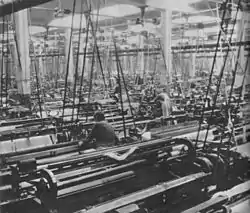
The post-war change of political and economic system meant the introduction of centrally planned socialist economy and political and economic integration to the USSR. For Łódź, this meant the re-opening of the eastern market and further development of the textile industry, mainly cotton and wool. New housing estates were built in large scale to accommodate the large growth of the new residents who moved to the city.
Two days after Łódź was captured by the Red Army an operational group came to town with Ignacy Loga-Sowiński as the representative of the Provisional Government. The next day the attorney approved the previously appointed Interim Presidium City Council, headed by Jan Waltratsu. Kazimierz Witaszewski was appointed the President of Łódź, and J. Waltratus became his deputy. In 1945, the Polish Workers' Party in the city numbered nearly 7,000 members and grew fast. Voivodeship structures were overseen by Ignatius Loga-Sowiński and municipal ones by Władysław Nieśmiałek. Until 1950, the Presidents (Mayor) of Łódź were: Kazimierz Witaszewski (until March 1945), Kazimierz Mijał (1945–1947), Eugeniusz Stawiński (1947–1949) and Marian Minor (1949–1950).[14]
For the first time, the Municipal National Council in Łódź (Polish: Rada Narodowa miasta Łodzi) met at the Municipal Theater on March 7, 1945. At the beginning of its existence, councilors were delegated to it on a parity basis (PPR and PPS were represented by 20 councilors each, SD by 10, SL by 5, 12 for the trade unions, 9 for the socio-cultural organizations and 2 for the youth organizations).[15]
The chairman of the Council was the president of Łódź Kazimierz Mijal, his deputy Jan Stefan Haneman (PPS), and the members of the presidium: Lucjan Głowacki, Artur Kopacz (SD) and Eugeniusz Stawiński. On May 8, 1945, Jan Stefan Haneman took the position of MRN chairman, followed by Edward Andrzejak (1946–1950).
In early 1946, the city territory was expanded up to 211.6 sqm. Included then in Łódź, incl. Ruda Pabianicka, Radogoszcz and Chojny and some communes: Rąbień, Brus, Widzew, Gospodarz, Wiskitno, Nowosolna, Dobra and Łagiewniki. City Hall (Polish: Rada Narodowa miasta Łodzi) was moved to the now expanded Juliusz Heinzel Palace in 104 Piotrkowska Street while the Izrael Poznanski Palace was the seat of the Presidium of the Voivodeship National Council of Lodz (Polish: Prezydium Wojewódzkiej Rady Narodowej w Łodzi.[16]
After the war, in 1945–48, Łódź served as the informal capital of Poland. Most central offices were temporarily relocated to Łódź, mainly due to the lack of damage in the city, unlike the massive destruction of Warsaw. Proximity of the city to Warsaw and its location in the center of the new Polish territory contributed to this decision. In the 1940s and 1950s, Łódź was changing rapidly – the area of the city was increased four times, the lack of damage attracted new residents (in 1951 already 646,000), the industry was nationalized and its industry structure changed. In addition to the still-dominant industrial function, Łódź is also becoming a large scientific, academic and cultural center. Already in 1945, the University of Lodz, the Lodz University of Technology, the State Music Conversatorium, the School of Fine Arts, the University of Rural Economy and the only Textile Institute in Poland were created, and in 1948 the famous State Film School (today's State Film School, TV and Theater).
Housing construction
Immediately after World War II, Łódź's general spatial development plans were developed. One of their main assumptions was the commencement of large-scale multi-family housing. There were more plans than implementation, but several estates in the 50s were created. They started with Bałuty district, not accidentally, as the poorest people of Łódź always lived there, so the choice was excellent from an ideological point of view. In addition, this was the location of Łódź Ghetto during the Holocaust and some buildings were demolished by the Germans, especially in the southern part, close to Polnocna Street, a fact which made it easier for constructing big housing estate. Bałuty was to become a representative part of Łódź and was planned to become a large, working-class housing estate. Kind of a counterweight to bourgeois Śródmieście, but also to the direction of the city's development. Until now Łódź has been developing towards the south while now the emphasis was towards the north. A huge residential district was to be built in Bałuty, designed by a team of architects from Warsaw from the Zakład Osiedli Robotniczych. Ryszard Karłowicz was its manager. He lived in the capital, but he came to Łódź for consultations. According to the assumptions, a housing estate for 40,000 residents of Łódź was to be built. The construction of another housing estate began in 1951. Called Bałuty I, it was designed by Łódź architects from Miastoprojekt, Bolesław Tatarkiewicz and Romuald Furmanek. It was built in the area of Wojska Polskiego street, Tokarzewskiego Street and Franciszkańska Street.[17]
Contemporary period
The economic crisis of the 1990s also had many positive consequences. It caused an increase in the importance of the services sector, including services of metropolitan (regional) significance, forced the restructuring of industry and the creation of special economic zones, which over time attracted new investors. At the turn of the 20th and 21st centuries, Łódź began to develop again, not as a "textile center". In 2010, the reconstruction of the downtown near the Łódź Fabryczna station began, along with the construction of the so-called 90 ha area. New Center of Łódź district (Polish: Nowe Centrum Łodzi) and Special Art Zone in the revitalized historic EC1 heat and power plant.
Gallery
 Izrael Poznański Factory, 1895
Izrael Poznański Factory, 1895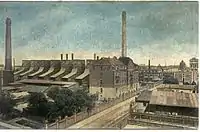 EC1 power plant, 19th-century postcard
EC1 power plant, 19th-century postcard Piotrkowska Street
Piotrkowska Street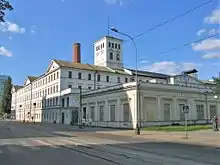 Ludwik Geyer's White Factory
Ludwik Geyer's White Factory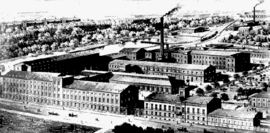 Karol Scheibler's Factory
Karol Scheibler's Factory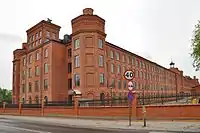 Księży Młyn, 2010
Księży Młyn, 2010.jpeg.webp)
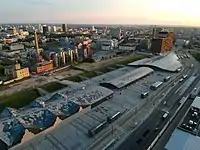 Łódź Fabryczna Railway Station
Łódź Fabryczna Railway Station
See also
References
- "Tak zaczęła się Łódź". Dziennik Lodzi. 3 August 2013. Retrieved 22 December 2019.
- Chrzanowski, Kanty. "Historia Łodzi do 1865 roku"
- "German Łódź". Centrum Dialogu (Dialog Center). Retrieved 2019-05-09.
- dr hab. Marek Barwiński. Rozwój przestrzenny oraz przemiany funkcjonalne i społeczne Łodzi – uwarunkowania geograficzno-polityczne
- dr hab. Marek Barwiński. Rozwój przestrzenny oraz przemiany funkcjonalne i społeczne Łodzi – uwarunkowania geograficzno-polityczne
- Order of the Grodzki Staroste of Lodz of September 1, 1939, "Kurier Łódzki", September 2, 1939, No. 242, p. 2.
- Wybuch wojny i poczatki okupacji hitlerowskiej w Łodzi
- Ruda Pabianicka od 1939 r. do 1946 r.
- Historie Łódzkie Historie Łódzkie
- Herb i barwy miasta
- Anna Gronczewska. Niemiec, który w czasie II wojny światowej rządził Łodzią; in "Polska. Dziennik Łódzki”, 28 VII 2017, pp. 10-11.
- Delegation of the Łódź Jewish commune in "Kurier Łódzki", 3-4 September 1939, No. 234, p. 5
- Bronisław Graczyk, Tadeusz Szymczak, Rady narodowe, w: "Łódź w latach 1945–1960", Łódź 1962, pp. 56-82
- Bronisław Graczyk, Tadeusz Szymczak, Rady narodowe, w: "Łódź w latach 1945–1960", Łódź 1962, pp. 56–82
- Bronisław Graczyk, Tadeusz Szymczak, Rady narodowe, w: "Łódź w latach 1945–1960", Łódź 1962, pp. 56–82
- Aleksander Dobroński. "Łódzkie budownictwo, czyli przeprowadzka z kamienic na wielkie osiedla" (url) (in Polish). Retrieved 2020-03-23.
Further reading
- Zysiak, Agata, et al. From Cotton and Smoke: Łódź: Industrial City and Discourses of Asynchronous Modernity, 1897-1994 (Krakow: Jagiellonian University Press, 2019) online review